My Houzz: Midcentury Style in a Welcoming Louisiana Home
Mark and Kitten Grote wanted a place in the countryside outside New Orleans. Their ideal place turned out to be a midcentury-modern home in Covington, Louisiana, that had been built by Kitten’s grandfather on land originally owned by her great-grandfather. After purchasing the home in 1984, the couple — she’s a learning specialist; he’s a sculptor and visual arts professor at Loyola University, New Orleans — went on to acquire nearly 6 acres of land surrounding the home, which they have turned into a lush garden oasis they call Hopewell Garden. They’ve also built a studio for Mark to work in, which doubles as a guest residence for visiting artists from around the world whom the couple hosts throughout the year.
Inside, the home is a mix of inherited midcentury furniture classics, occasional antiques, baskets and artwork picked up during their international travels, and personal collections and artwork. And though the home has undergone some renovations since the Grotes purchased it and also sustained damage from Hurricane Katrina, it remains a personal and eclectic space that reflects both family history and their personal interests.
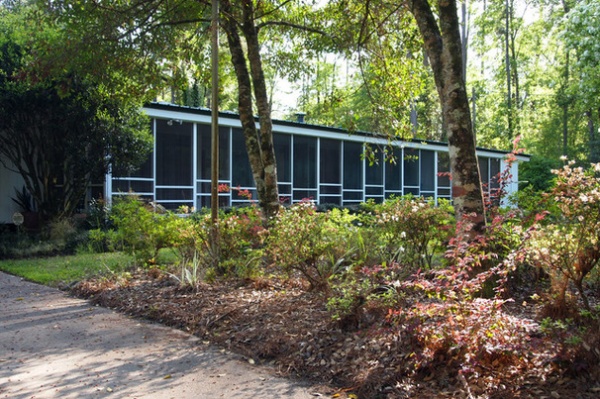
Houzz at a Glance
Who lives here: Kitten and Mark Grote; their dog, Pippin; and cats T.S. and Cat Cat
Location: Covington, Louisiana
Size: The main house is 3,000 square feet (279 square meters), 3 bedrooms, 3 bathrooms; the studio is 3,600 square feet (334.4 square meters) and includes a 2-bedroom, 1-bathroom apartment
Year built: Main house: 1962; studio: 1984
The house features two large screened-in porches that stretch the length of the house on two sides. It’s also wrapped with large windows so the couple can enjoy the beauty of the gardens outside throughout the year.
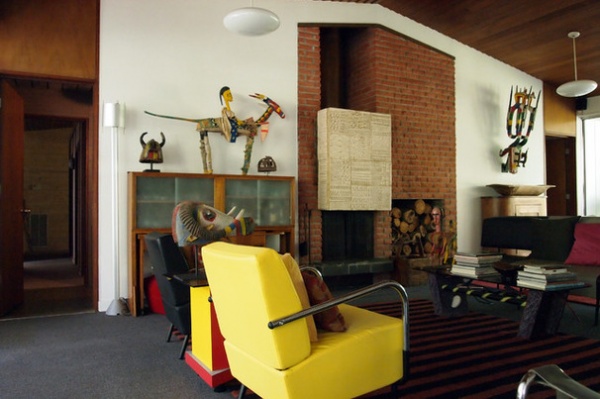
Plenty of natural light pours into the main living space, thanks to the large windows on either side of the room.
During the winter the couple enjoy the warmth provided by the exposed brick fireplace. The sand-casting piece on their unique mantel was created by artist John Clemmer, a former faculty member at the Newcomb College School of Art. The sofa was designed especially for this home by architect John W. Lawrence.
The frosted glass cabinet seen here is one of Mark and Kitten’s favorite pieces of furniture, because it also folds out to form a table. They found it in an antiques store when they were living in Honiton, England.
Side table: Mark Grote
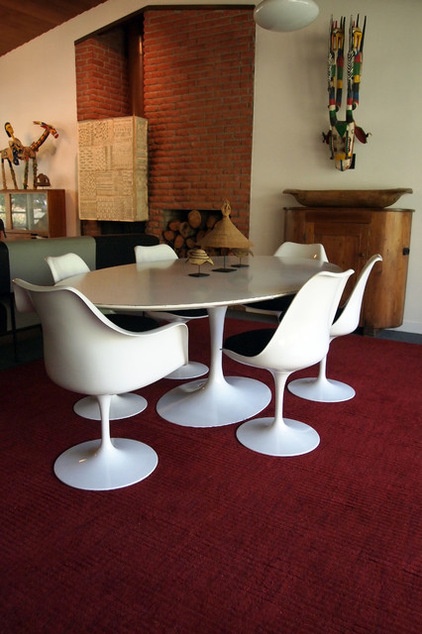
The entire room is decorated in warm, rich colors that complement the color palette of the African artifacts that fill the house, like this wall-mounted Bambara antelope marionette head. Mark and Kitten collect interesting objects like these that have character and a story. These artifacts are an interesting contrast to the midcentury pieces that fit the style of the house.
Tulip table, armchairs, side chairs: Saarinen
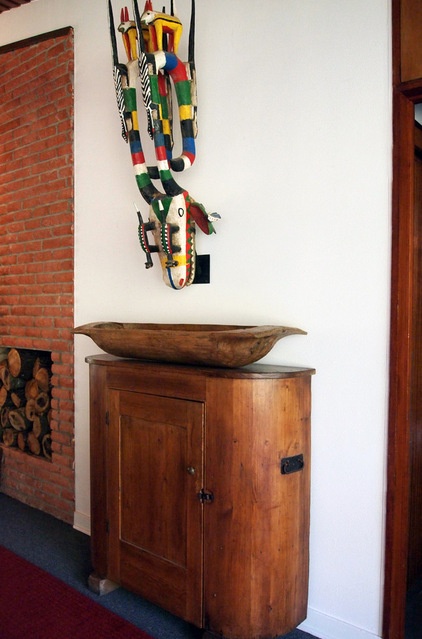
This antelope head sculpture is a montage of many symbolic creatures, including snakes, birds and other four-legged animals. Mark and Kitten have purchased most of their African pieces from the Davis Gallery.
An 1820s warming cabinet sits along the wall next to the table. With its open back and copper-lined interior, it was designed with handles to be a piece of movable furniture that could be placed next to a kitchen fireplace to absorb the heat. Serving dishes would then be placed on top to keep them warm. Mark and Kitten acquired this piece from an antiques store a few days after they got married. They loved that cabinets like this were typically used in manor houses in England.
The wooden basket that sits on top of it was originally used by millers to measure wheat.
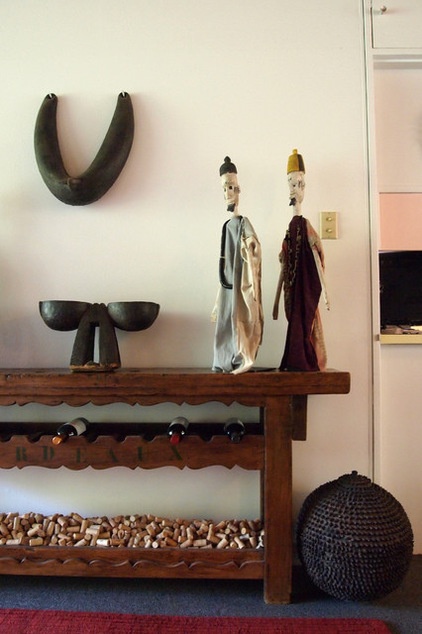
This antique wood table started life as a harness maker’s bench. It has been repurposed as a wine rack and a place to corral the couple’s wine corks.
The marionettes are from Mali, in West Africa.
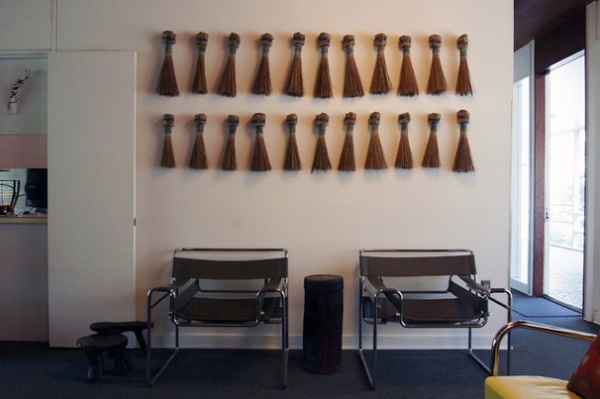
Above a pair of Wassily chairs is an art piece that Mark completed during his time in the Gasworks residency program in London. This untitled sculpture is a reappropriation of African brushes that were typically used to clean pots, which Mark found while he was living in London. Many of Mark’s sculptures involve found objects and objects of interest, including things from junk stores and antiques stores and even trash that he finds on the streets. He is also inspired by cultural objects.
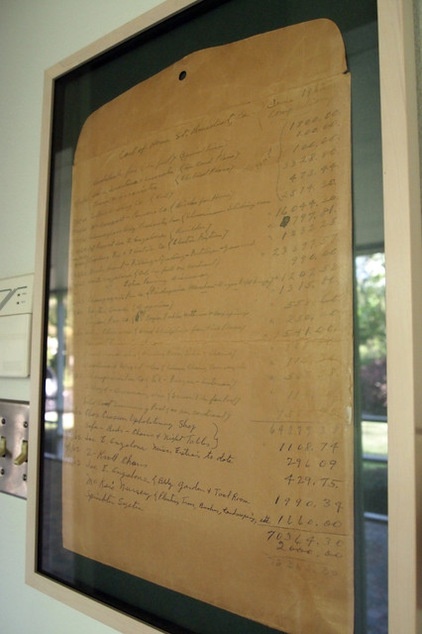
Kitten’s grandfather Wiley Mossy, who built this house on the land his father owned, created a list of everything that was originally in the home along with its value. The couple framed it to have on display in their hallway.
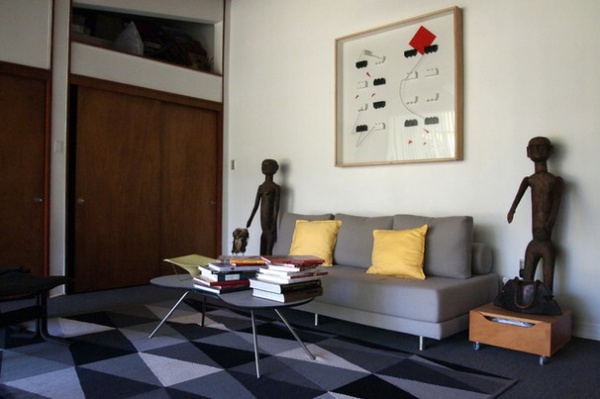
This guest bedroom is decorated in cool, neutral colors that serve as a backdrop for two African sculptures.
Basket on table: Ray-Tray, Sandy Chilewich
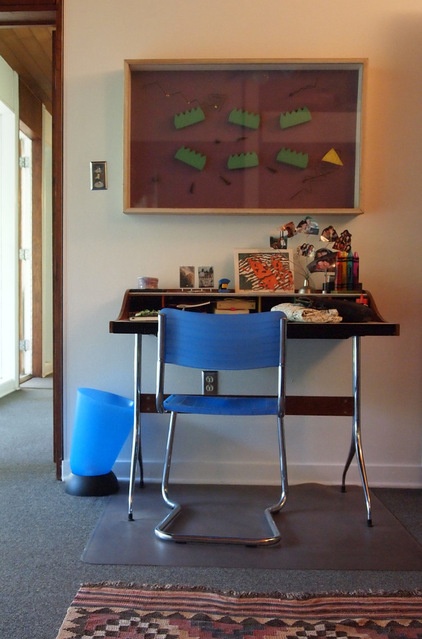
A third bedroom faces the backyard gardens and was originally designated as a room for the couple’s two sons. It is now their daughter’s room when she comes to stay.
Nelson Swag Leg Desk; art: Mark Grote
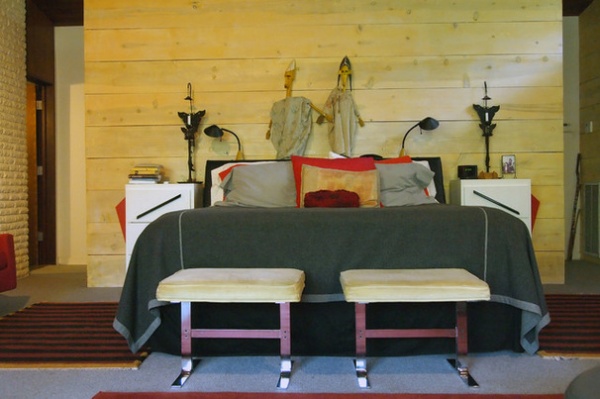
The couple decided that adding a master bedroom would make the house more functional for them. Mark designed and built the master bedroom addition himself in the early ’90s when Kitten was pregnant with their daughter.
Although they were excited about the idea of adding on to the house, they were also concerned about respecting its original aesthetic. They looked at many other Lawrence houses and other examples of midcentury modern homes before building.
Side tables: Mark Grote; footstools: Knoll
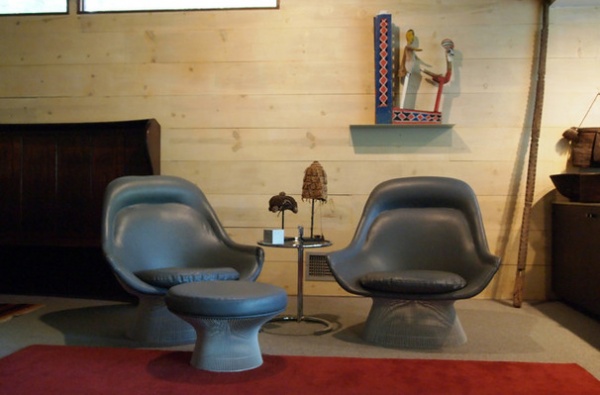
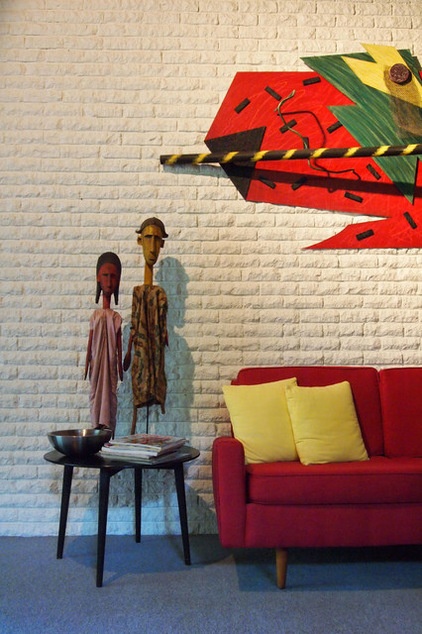
The addition consists of a master bedroom with multiple sitting areas, a master bathroom and a large closet for storage. They used natural pine wood, a brick wall and large windows so the addition would match the home’s existing midcentury look. The brick wall behind the red couch was actually the exterior wall of the house that they painted. The ceiling of the master bedroom is made of redwood. Kitten notes that they were lucky that they were able to use redwood, because shortly after the renovation, the price of redwood skyrocketed.
Eileen Gray Adjustable Table; Platner Armchair and Ottoman (re-covered); couch: Knoll; sculpture: Mark Grote
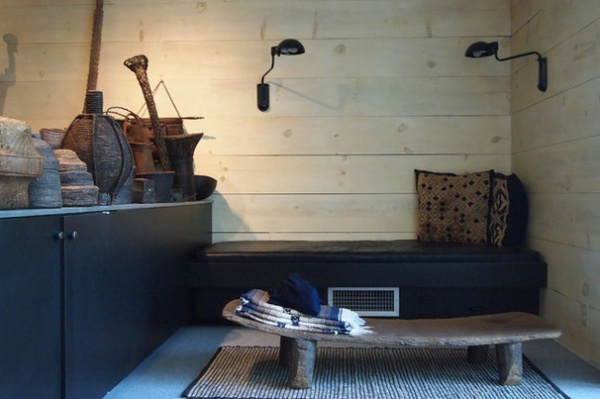
Kitten’s large collection of baskets from Congo and Nigeria is a centerpiece in the master bedroom. It also serves as a room partition, separating the bedroom from the sitting area by the window. This built-in sitting and reading area includes a traditional African bed.
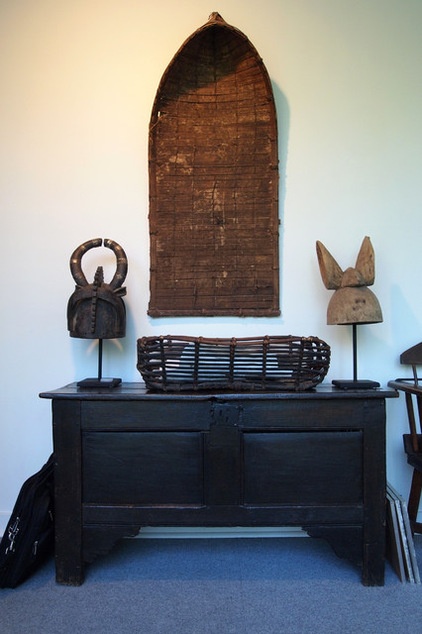
Other pieces the couple have picked up on their travels share space in this room as well. Atop a trunk from the Netherlands is an African cradle (center), and a large West African hat is mounted on the wall.
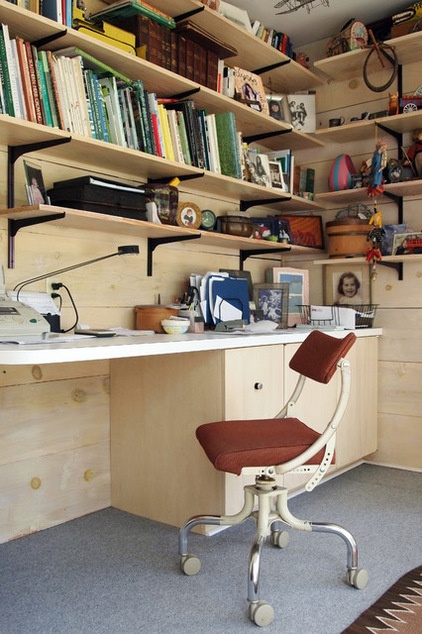
The office, which sits off the master bedroom, is flooded with afternoon light. This is also where Kitten and Mark house some of their most interesting collected pieces. In addition to her African basket collection, Kitten has a collection of dolls and toys that she has acquired over the years, some of which date to the 19th century.
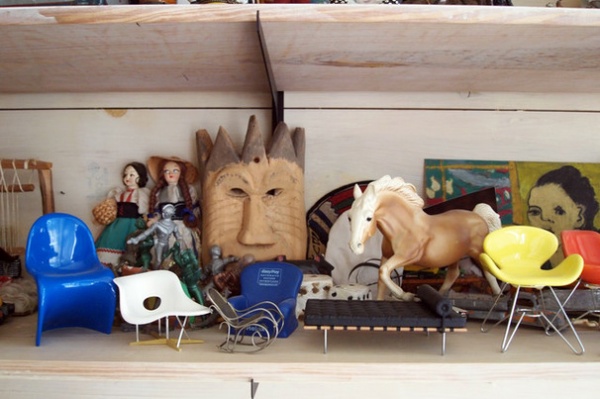
A Knoll miniatures collection sits alongside vintage toys, marionettes and African artifacts.
Kitten already had full-size Knoll furniture pieces, which she had inherited from her parents. She started collecting the miniatures because she had so much admiration for modern furniture and she had grown up with this type of furniture. She also thought that these pieces would be interesting to display with the vintage toys that Mark’s mother had kept from his childhood and passed down to him.
“When I started collecting the Knoll miniatures in the ’80s, furniture dealers used them for advertising purposes. Some of them would sell the models, but others wouldn’t. Design Within Reach made the models popular, but I never bought from them; I always bought them from furniture dealers. Now you can buy them at places like the Museum of Modern Art,” Kitten says.
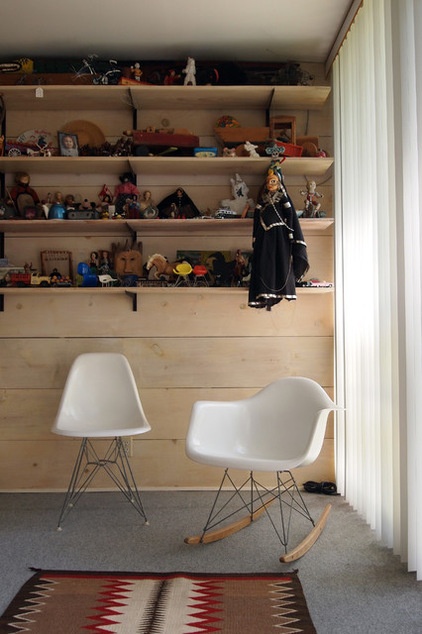
Hanging on the right side of the shelf is a fascinating 1980s Hindu puppet, a gift from Kitten and Mark’s daughter-in-law. The Eames chairs with their whimsical wire bases are also playful and fun, and complement the toys and old treasures.
Eames Molded Fiberglass Chair with Eiffel Base (left); Eames Molded Fiberglass Rocker (right)
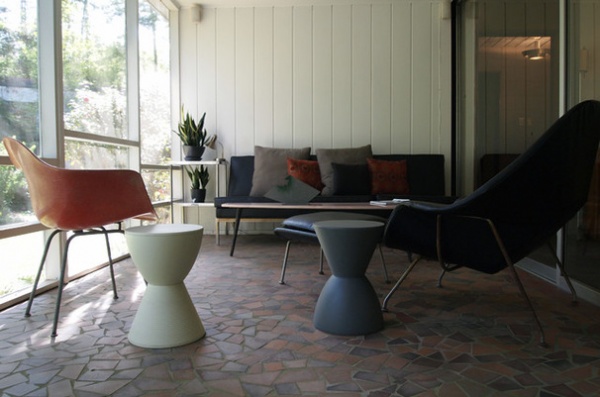
During spring and summer, the outdoor spaces — porches, patio, gardens and pool — become the couple’s primary living space. They spend their days gardening, grilling and enjoying the warm Louisiana weather.
Eames Molded Fiberglass 4-Leg Armchair (left); Saarinen Womb Chair and Ottoman (right); side tables: Philippe Stark
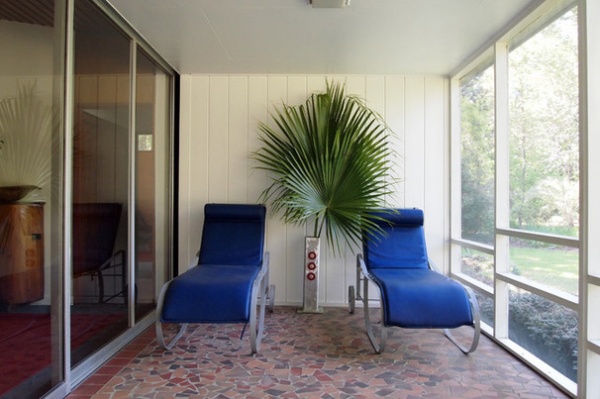
Mark found these lounge chairs at an antiques shop in Covington and had a local upholsterer make the cushions. He and Kitten have a keen eye for good design and love giving found objects their own stylistic flourishes.
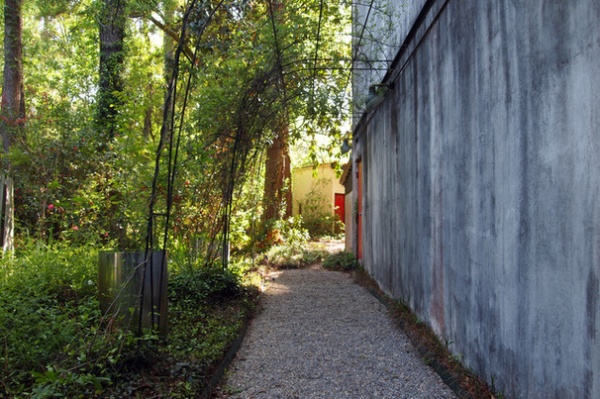
In 1984, just months after buying the property, the couple designed and built a large studio and apartment on the land behind the house. It took three months to complete. Although the studio and the main house are architecturally similar, the studio has a much more industrial feel, with concrete, plywood and steel finishes.
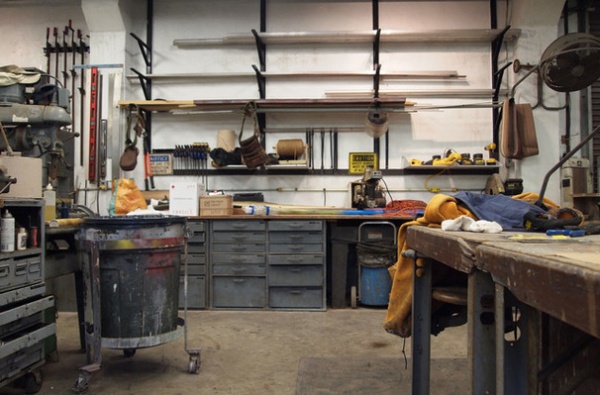
Mark and Kitten participate in residency programs and house exchanges with other artists around the world. The sculpture studio serves as a perfect space for visitors, as it’s private and separate from the main house and includes all the modern amenities as well as access to the work studio downstairs.
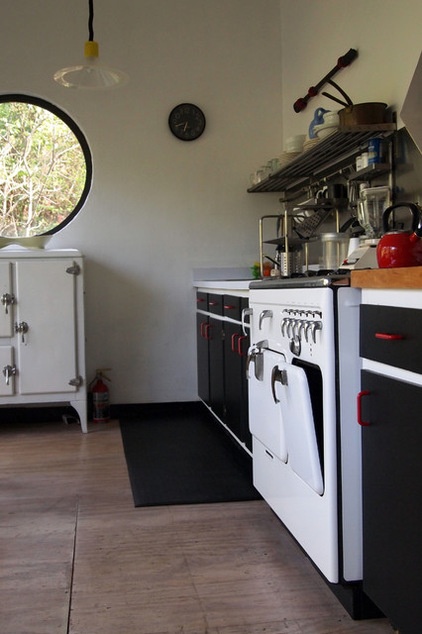
This studio building was designed around three shapes: square, circle and triangle. These shapes are repeated in details throughout the space, including the windows, cutouts between the rooms and the slope of the roof.
The studio kitchen has a vintage stove and icebox. Mark says, “My mom was a scrounger, like I am. She found this [icebox] in an abandoned building in Ohio.”
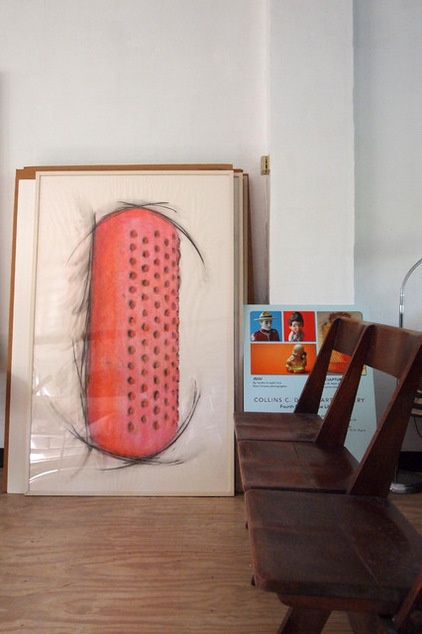
These wooden chairs were salvaged from a nearby church, St. Joseph’s Abbey. Next to them sits one of Mark’s drawings.
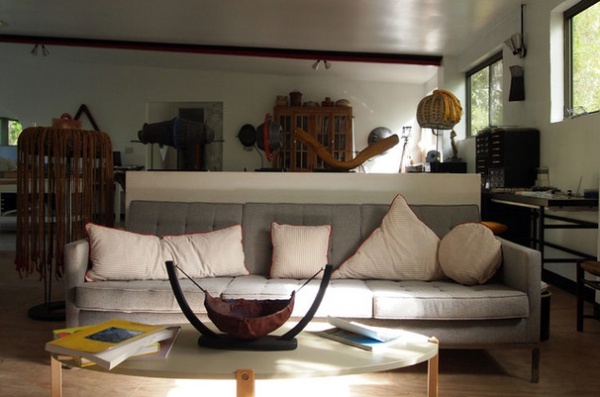
The living space in the upstairs apartment is large and open. The space is divided by large pieces of furniture, like couches, bookcases and benches. This gray wool Knoll sofa survived Hurricane Katrina, needing only a thorough cleaning of its original upholstery to bring it back to life.
Covington didn’t experience the same amount of flooding that New Orleans did in the aftermath of Hurricane Katrina, but as the storm passed through St. Tammany Parish (“parish” is the equivalent of “county” in Louisiana), it brought with it some of the worst winds of the hurricane. The Grote family evacuated to Dallas, but their home was still in harm’s way.
“When we returned to our house, we couldn’t even see it because there were so many fallen trees and debris,” says Kitten. Five pine trees fell on their home, but there wasn’t any structural damage. Most of the damage was to the master bedroom addition, which they say was the best place for something to go wrong because Mark had built it and therefore knew how to restore it.
When Kitten and Mark entered the home after the storm, they found that all of the African baskets were filled to the brim with rainwater. Kitten sought advice from the Smithsonian Institution on how to restore the African marionettes and baskets. It has taken countless treatments to restore the baskets to their original color.
They weren’t as lucky with some of the furniture. “We had an original Eames banquet table made from zebrawood that was destroyed,” says Kitten. They also had to throw out a number of beautiful leather chairs from the ’50s. “We had no idea the amount of damage that could happen,” she adds.
It took them about 18 months to restore the property. “We are so much more resilient now. We had to move on,” says Kitten.

The garden was also destroyed by Hurricane Katrina. Most of the plants that weren’t killed in the storm were crushed by heavy machinery in the cleanup effort. Pine trees and a few large oaks are nearly the only plants left from the original garden.
This treehouse was one of the few things from the garden that wasn’t destroyed. It was one of the first projects the couple completed after buying the home. It was enjoyed by all three of their children and now, three decades later, it is enjoyed by a another generation when Mark and Kitten’s grandson comes to visit.
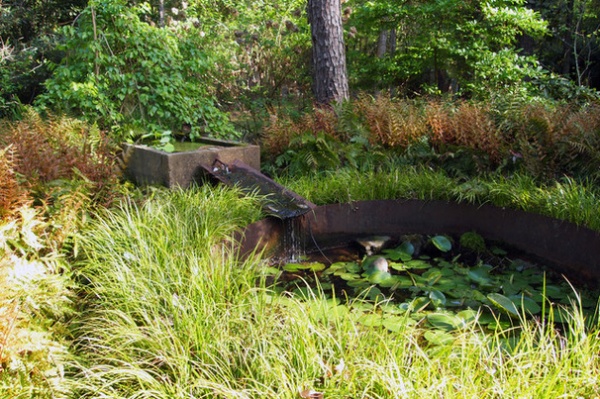
The gardens around the house are filled with other personal touches, such as this fountain, which Mark built from a horse trough also found at St. Joseph’s Abbey. He also built this large ring that has become the second tier of the pond, which is now covered in lily pads.
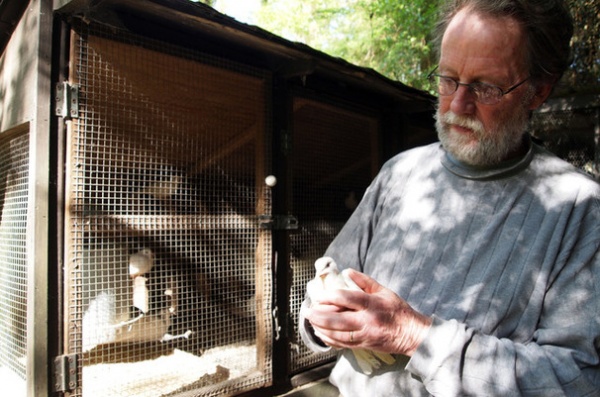
On the grounds Mark and Kitten have chickens, ducks, bees, pigeons and doves, such as this one. All of them are housed in handmade coops and cages.
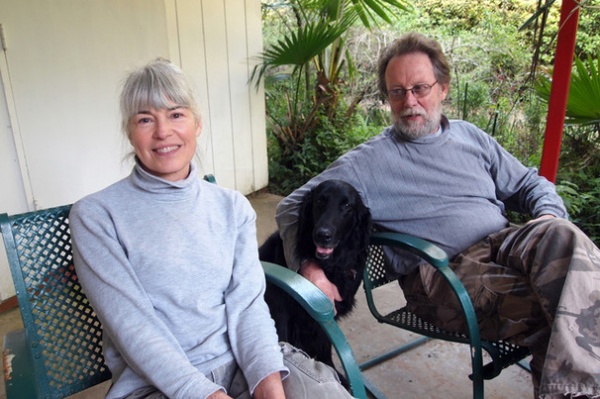
Kitten and Mark relax on their patio with their dog Pippin.
“What makes our house unique is that it has been kept true to the way it was built. Mark and I have revered everything that the architect has built,” says Kitten. They haven’t changed it; they’ve enhanced its original beauty.
My Houzz is a series in which we visit and photograph creative, personality-filled homes and the people who inhabit them. Share your home with us and see more projects.
Browse more homes by style:
Small Homes | Colorful Homes | Eclectic Homes | Modern Homes | Contemporary Homes | Midcentury Homes | Ranch Homes | Traditional Homes | Barn Homes | Townhouses | Apartments | Lofts | Vacation Homes












